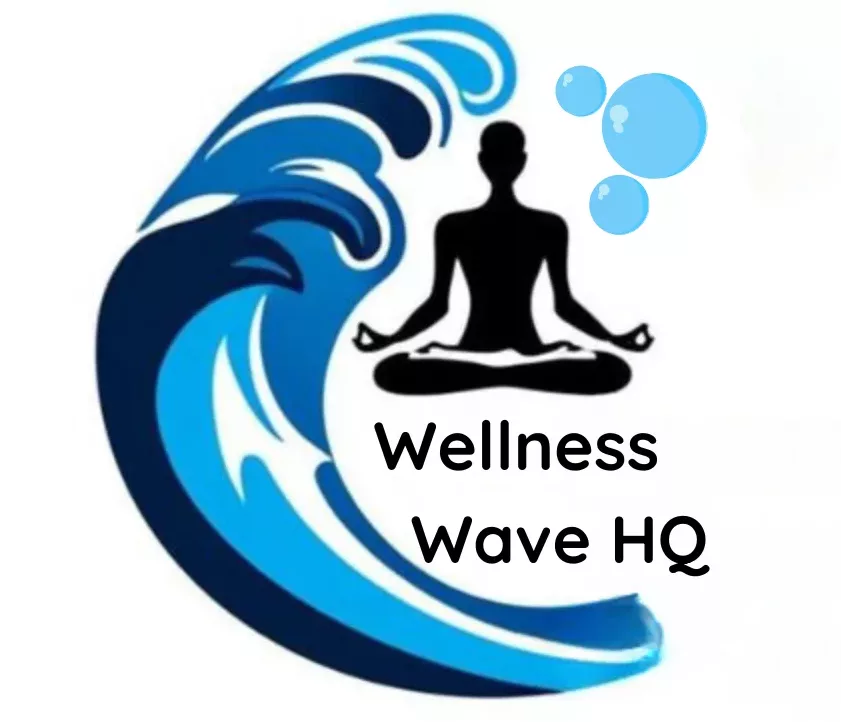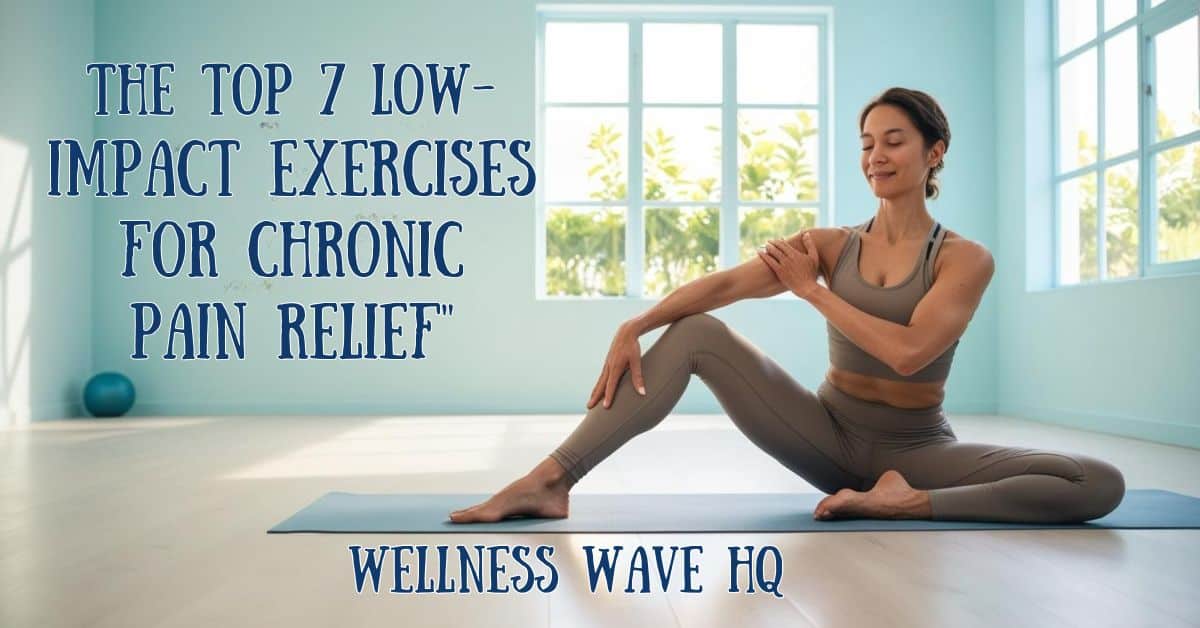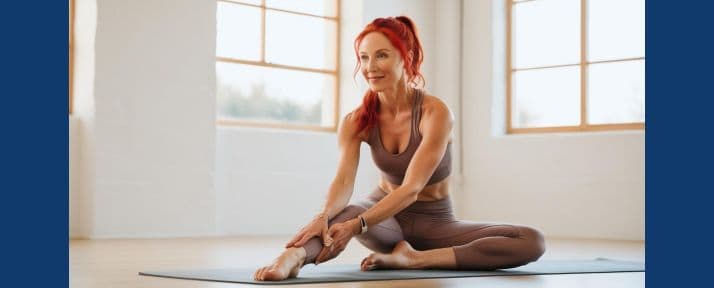🔹 Struggling with Chronic Pain? These Low-Impact Exercises Can Help!
The truth is, most workouts make it worse—unless you’re doing the right low-impact exercises for chronic pain. If you live with chronic pain, you’ve likely been told to “just exercise” more times than you can count. But let’s be honest—most traditional workouts only make things worse. High-impact exercises can trigger flare-ups, leaving you in even more pain than before.
The good news? Movement doesn’t have to hurt. With the right low-impact exercises, you can build strength, impro ve mobility, and reduce pain—without stressing your body.
So, what are the best exercises? Let’s dive into the top 7 low-impact workouts scientifically proven to help chronic pain sufferers regain control, move freely, and feel better—one step at a time.
🛠️ The Power of Low-Impact Exercises for Chronic Pain Relief
If you’re wondering whether gentle movement can truly ease chronic pain, science says YES. Studies show that consistent, low-impact exercise can have profound effects on reducing pain, improving mobility, and boosting overall well-being—without causing further harm.
💡 But let’s be real—if you live with chronic pain, you might be afraid that any movement will make things worse. This fear is completely valid. Many pain sufferers avoid exercise because past attempts have led to flare-ups or discomfort.
The good news? Not all movement is harmful. When done correctly, low-impact exercises work with your body—not against it. They help strengthen muscles, improve circulation, and even regulate pain perception, making them a safe and effective tool for pain management.
🔬 Here’s how gentle movement helps relieve chronic pain:
✔️ Reduces Pain & Inflammation – Regular movement promotes better blood flow, flushing out pain-inducing toxins and lowering inflammation. Studies suggest that low-impact exercises decrease inflammatory markers like C-reactive protein (CRP), which is linked to chronic pain conditions. (Source: Arthritis Foundation)
✔️ Improves Flexibility & Joint Health – When we stop moving, our muscles tighten, joints stiffen, and mobility declines. Low-impact activities gradually improve range of motion and keep joints lubricated, making daily movement easier. (Source: National Institute on Aging)
✔️ Regulates Pain Perception – Chronic pain can make the nervous system hypersensitive to pain signals. Movement helps “retrain” the brain by releasing endorphins, our body’s natural painkillers. (Source: Mayo Clinic)
✔️ Enhances Strength & Stability – Weak muscles put extra strain on joints, worsening pain over time. Strength-building low-impact exercises help reduce stress and discomfort. (Source: Harvard Medical School)
✔️ Boosts Mental Health & Lowers Stress – Chronic pain and mental health are deeply connected. Studies show that low-impact exercise reduces anxiety, depression, and stress-related flare-ups. (Source: American Psychological Association)
🚨 Overcoming the Fear of Movement: Safe Steps to Start Exercising with Chronic Pain
Many people with chronic pain hesitate before starting a fitness routine—worried that movement will lead to flare-ups, stiffness, or injury.
But here’s the truth: The key is starting slow, choosing the right exercises, and listening to your body.
✅ Start with Just 5 Minutes a Day – Even short bursts of gentle movement can make a difference. Try light stretching, chair yoga, or a short walk.
✅ Focus on Low-Impact, Gentle Movements – Avoid high-impact exercises (running, jumping) and instead choose walking, swimming, tai chi, or yoga.
✅ Use Pain as Your Guide—Not a Stop Sign – Mild discomfort is okay, but sharp or lingering pain means you should modify or rest.
✅ Incorporate Recovery Days – Movement is important, but so is rest. Plan restorative activities like deep breathing, stretching, or heat therapy.
✅ Modify as Needed – Not every exercise will feel good. Find what works for YOU and adjust accordingly.
🔹 Pro Tip: If you’re unsure how to begin, consider working with a physical therapist or trying guided exercise apps designed for chronic pain relief.

💪 The Top 7 Low-Impact Exercises for Chronic Pain Relief
Each of these exercises is gentle on your body while delivering powerful pain-relief benefits.
1️⃣ Walking 🚶♂️
✔️ Increases circulation and reduces stiffness.
✔️ Strengthens muscles to support joints.
✔️ Easy to modify based on pain levels.
📝 Pro Tip: Start with 5-10 minutes and build up. Soft terrain (grass, tracks) is gentler than pavement.
2️⃣ Swimming & Water Therapy 🏊♂️
✔️ Zero-impact exercise—water supports your body weight.
✔️ Natural resistance strengthens muscles with less strain.
✔️ Great for arthritis & fibromyalgia. (Source: Arthritis Foundation)
📝 Pro Tip: Warm water pools soothe stiff joints even more!
3️⃣ Yoga 🧘♀️
✔️ Enhances flexibility & mobility without stress.
✔️ Calms the nervous system to reduce pain perception.
✔️ Boosts mental clarity & lowers stress. (Source: Verywell Health)
📝 Pro Tip: Try gentle yoga styles like Hatha or Restorative Yoga — both are excellent low-impact exercises for chronic pain.
4️⃣ Tai Chi 🌀
✔️ Improves balance & coordination to prevent falls.
✔️ Encourages slow, controlled movements (pain-friendly).
✔️ Focuses on breath & relaxation to ease stress-related pain. (Source: Harvard Health)
📝 Pro Tip: Practicing 10 minutes a day can improve flexibility and reduce inflammation.
5️⃣ Pilates 💆♀️
✔️ Strengthens core muscles for better posture & pain relief.
✔️ Increases flexibility without straining joints.
✔️ Perfect for back pain & joint stiffness. (Source: PubMed)
📝 Pro Tip: Look for Pilates for chronic pain or senior-friendly Pilates classes.
6️⃣ Cycling (Stationary or Outdoor) 🚴♂️
✔️ Great for cardiovascular health without high impact.
✔️ Strengthens leg muscles without overloading knees.
✔️ Easy to adjust resistance for comfort.
📝 Pro Tip: Use recumbent bikes for extra lower-back support.
7️⃣ Resistance Band Workouts 🏋️♂️
✔️ Builds strength safely without heavy weights.
✔️ Supports joint health and improves muscle tone.
✔️ Versatile & can be done anywhere!
📝 Pro Tip: Start with light resistance bands and increase gradually.
📌 Incorporating Low-Impact Exercises into Your Routine
✔️ Consult a Professional: Before starting, talk to a doctor or physical therapist to ensure safety. (Source: Novus Spine Center)
✔️ Start Slowly: Begin with short sessions and gradually increase intensity.
✔️ Listen to Your Body: Adjust exercises if pain increases.
✔️ Stay Consistent: Regular movement = better pain management.
These low-impact exercises for chronic pain can be tailored to your comfort level, helping you stay active without causing flare-ups.
🌟 Final Thoughts: Take Control of Your Pain with Movement
Chronic pain doesn’t mean giving up on movement—it means finding the right low-impact exercises for chronic pain that support healing and strength.
🚀 Ready to take the first step?
✔️ Pick ONE exercise from this list and try it today.
✔️ Track how your body responds and adjust as needed.
✔️ Stay consistent—even 5 minutes a day makes a difference!
📌 Bookmark this page so you can revisit your plan anytime!
📢 Engage with us! Share this guide with friends or loved ones who might benefit.
💬 Leave a comment below: What’s your favorite low-impact exercise? Have questions about getting started? Let’s build a community of support together!
🔥 Take charge of your health—find movement that works for YOU!
❓ FAQ: Your Low-Impact Exercise Questions Answered
🔹 Q: How often should I do low-impact exercises?
💡 A: Aim for at least 150 minutes per week (about 30 minutes, 5 days a week).
🔹 Q: Can low-impact exercises help with weight loss?
💡 A: Yes! Combined with a balanced diet, they help burn calories, build muscle, and improve metabolism.
🔹 Q: What if I have a pain flare-up?
💡 A: Modify movements, reduce intensity, or try gentler options like stretching or deep breathing.
🔹 Q: Can I combine different low-impact exercises?
💡 A: Absolutely! Mixing exercises keeps workouts fun and engages different muscle groups.
JOIN OUR COMMUNITY!!




This article feels like a gentle invitation to rethink how we move our bodies, especially when chronic pain tries to hold us back. I would say it’s thought-provoking in its reminder that even small, mindful movements like a short walk or a few minutes of yoga can make a significant difference in how we feel day to day. What I really appreciate is the emphasis on listening to your body and adapting the exercise to your own pace. It challenges the notion that movement always has to be intense, showing instead that healing and strength can come from even the gentlest of practices. This perspective not only empowers those dealing with pain but also encourages us all to find creative, sustainable ways to nurture our well-being.
Hi Dan,
Thank you for your thoughtful comment! I’m so glad you found the article to be a gentle reminder of how even small, mindful movements can have a big impact on managing chronic pain. I completely agree that listening to our bodies is key—sometimes it’s not about pushing through the pain, but finding what feels right for us and embracing gentle, sustainable practices that promote healing.
It’s great to hear that the article resonated with you in that way. Movement doesn’t always need to be intense to make a positive difference, and I love how you highlighted the importance of adapting exercise to our own pace. It’s definitely a more empowering and mindful approach to fitness, especially for those living with chronic pain.
Thanks again for your valuable perspective—looking forward to hearing more from you!
Best,
Courtney